

Postcolonialism. C. G. Jung's Psychology of Religion and Synchronicity. Rudolph Auto preacher feeling of numinous. Moctezuma. Topiltzin Quetzalcoatl: The Once and Future Lord of the Toltecs. Quetzalcoatl and the irony of Empire. Miss Legend of Quetzalcoatl. A glossary of Jungian terms. I collected these terms and concepts on my journey through Jung's letters, seminars, and Collected Works as well as from my studies in Depth Psychology.

Terms defined elsewhere in this document appear in italics. You might also want to peruse my Glossary of Freudian Terms and some quotations by James Hillman and Alfred Adler. And of course we all need to get Horney now and then. Abaissement du niveau mental: French psychologist Pierre Janet's term, elaborated by Jung, for a weakening of the ego due to an unconscious drainage of its psychological energy.
Field models. Richard onians the origin of european thought. Demos. Semantics definition. Kairos. Sopo and Miller temporality and Power. Projective identification. Projective identification may be used as a type of defense, a means of communicating, a primitive form of relationship, or a route to psychological change;[5] used for ridding the self of unwanted parts or for controlling the other's body and mind.[6] Experience[edit] Though a difficult concept for the conscious mind to come to terms with,[7] since its primitive nature makes its operation or interpretation seem more like magic or art than science,[8] projective identification is nonetheless a powerful tool of interpersonal communication.
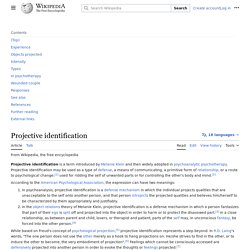
The recipient of the projection may suffer a loss of both identity and insight as they are caught up in and manipulated by the other person's fantasy.[9] One therapist, for example, describes how "I felt the progressive extrusion of his internalized mother into me, not as a theoretical construct but in actual experience. The intonation of my voice altered, became higher with the distinctly Ur-mutter quality. Objects projected[edit] Intensity[edit] R. R. Psychic or unconscious infection. Emotional Contagion. Participation Mystique. Mario Jacoby's model. Numinous. Imitative learning. Imitative learning is a type of social learning whereby new behaviors are acquired via imitation.[1] Imitation aids in communication, social interaction, and the ability to modulate one's emotions to account for the emotions of others, and is "essential for healthy sensorimotor development and social functioning".[1] The ability to match one's actions to those observed in others occurs in humans and animals;[1] imitative learning plays an important role in humans in cultural development.[2] Imitative learning in animals[edit] References[edit]
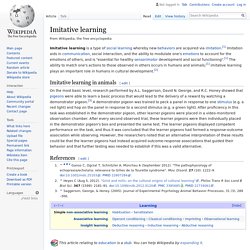
Alvin goldman. Ideomotor phenomenon. Ideomotor phenomenon is a psychological phenomenon wherein a subject makes motions unconsciously.
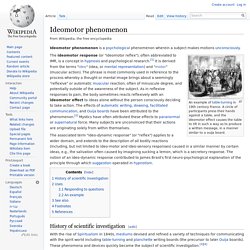
An example of table-turning in 19th century France. A circle of participants press their hands against a table, and the ideomotor effect causes the table to tilt in such a way as to produce a written message, in a manner similar to a ouija board. The ideomotor response (or "ideomotor reflex"), often abbreviated to IMR, is a concept in hypnosis and psychological research.[1] It is derived from the terms "ideo" (idea, or mental representation) and "motor" (muscular action). The phrase is most commonly used in reference to the process whereby a thought or mental image brings about a seemingly "reflexive" or automatic muscular reaction, often of minuscule degree, and potentially outside of the awareness of the subject. As in reflexive responses to pain, the body sometimes reacts reflexively with an ideomotor effect to ideas alone without the person consciously deciding to take action. Uses[edit] Simulation theory.
Nerve. A nerve is an enclosed, cable-like bundle of axons (nerve fibers, the long and slender projections of neurons) in the peripheral nervous system.
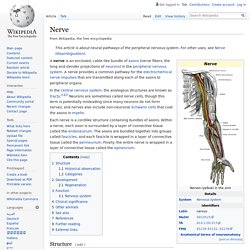
A nerve provides a common pathway for the electrochemical nerve impulses that are transmitted along each of the axons to peripheral organs. In the central nervous system, the analogous structures are known as tracts.[1][2] Neurons are sometimes called nerve cells, though this term is potentially misleading since many neurons do not form nerves, and nerves also include non-neuronal Schwann cells that coat the axons in myelin.
Sympathetic nervous system. Autonomic nervous system. The autonomic nervous system (ANS or visceral nervous system or involuntary nervous system) is the part of the peripheral nervous system that acts as a control system that functions largely below the level of consciousness to control visceral functions,[1] including heart rate, digestion, respiratory rate, salivation, perspiration, pupillary dilation, micturition (urination), sexual arousal, breathing and swallowing.
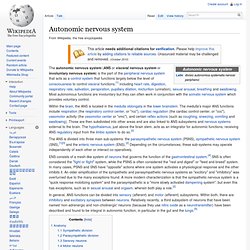
Most autonomous functions are involuntary but they can often work in conjunction with the somatic nervous system which provides voluntary control. Parasympathetic nervous system. The parasympathetic nervous system (PSNS) is one of the two divisions of the autonomic nervous system (a division of the peripheral nervous system (PNS)), the other being the sympathetic nervous system.[1][2] (The enteric nervous system (ENS) is now usually referred to as separate from the autonomic nervous system since it has its own independent reflex activity.)
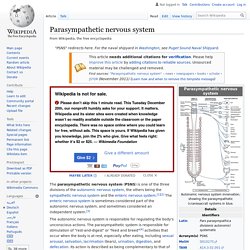
The autonomic nervous system is responsible for regulating the body's unconscious actions. The parasympathetic system is responsible for stimulation of "rest-and-digest" or "feed and breed"[3] activities that occur when the body is at rest, especially after eating, including sexual arousal, salivation, lacrimation (tears), urination, digestion and defecation. Its action is described as being complementary to that of the sympathetic nervous system, which is responsible for stimulating activities associated with the fight-or-flight response.
Structure[edit] Cranial nerves[edit] Enteric nervous system. The enteric nervous system (ENS) or intrinsic nervous system is one of the main divisions of the autonomic nervous system (ANS) and consists of a mesh-like system of neurons that governs the function of the gastrointestinal tract.[1] It is capable of acting independently of the sympathetic and parasympathetic nervous systems, although it may be influenced by them.
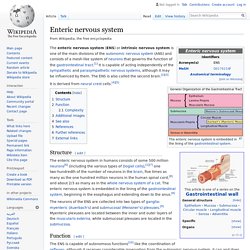
The ENS is also called the second brain.[2][3] It is derived from neural crest cells.[4][5] Structure[edit] The enteric nervous system in humans consists of some 500 million neurons[6] (including the various types of Dogiel cells),[1][7] one two-hundredth of the number of neurons in the brain, five times as many as the one hundred million neurons in the human spinal cord,[8] and about 2/3 as many as in the whole nervous system of a cat. Blood cell. Red blood cells (erythrocytes)White blood cells (leukocytes)Platelets (thrombocytes) Together, these three kinds of blood cells add up to a total 45% of the blood tissue by volume, with the remaining 55% of the volume composed of plasma, the liquid component of blood.[1] Red blood cells[edit] Red and white human blood cells as seen under a microscope using a blue slide stain Red blood cells or erythrocytes, primarily carry oxygen and collect carbon dioxide through the use of hemoglobin.
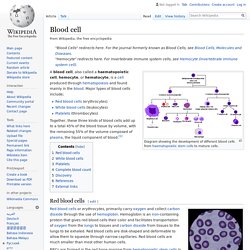
Hemoglobin is an iron-containing protein that gives red blood cells their color and facilitates transportation of oxygen from the lungs to tissues and carbon dioxide from tissues to the lungs to be exhaled. Red blood cell. In humans, mature red blood cells are flexible and oval biconcave disks.
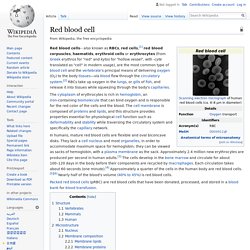
They lack a cell nucleus and most organelles, in order to accommodate maximum space for hemoglobin; they can be viewed as sacks of hemoglobin, with a plasma membrane as the sack. Approximately 2.4 million new erythrocytes are produced per second in human adults.[3] The cells develop in the bone marrow and circulate for about 100–120 days in the body before their components are recycled by macrophages. Each circulation takes about 60 seconds (one minute).[4] Approximately a quarter of the cells in the human body are red blood cells.[5][6] Nearly half of the blood's volume (40% to 45%) is red blood cells. Packed red blood cells (pRBC) are red blood cells that have been donated, processed, and stored in a blood bank for blood transfusion. Structure. Oxygen. Chemical element with atomic number 8 Dioxygen is used in cellular respiration and many major classes of organic molecules in living organisms contain oxygen, such as proteins, nucleic acids, carbohydrates, and fats, as do the major constituent inorganic compounds of animal shells, teeth, and bone.
Most of the mass of living organisms is oxygen as a component of water, the major constituent of lifeforms. Oxygen is continuously replenished in Earth's atmosphere by photosynthesis, which uses the energy of sunlight to produce oxygen from water and carbon dioxide. Oxygen is too chemically reactive to remain a free element in air without being continuously replenished by the photosynthetic action of living organisms. Another form (allotrope) of oxygen, ozone (O3), strongly absorbs ultraviolet UVB radiation and the high-altitude ozone layer helps protect the biosphere from ultraviolet radiation. Third Eye - Pineal Gland. Third Eye - Pineal Gland The pineal gland (also called the pineal body, epiphysis cerebri, epiphysis or the "third eye") is a small endocrine gland.
It produces melatonin, a hormone that affects the modulation of wake/sleep patterns and photoperiodic (seasonal) functions. Fillmore Fulfilled: Pineal Gland. « Back to Fillmore Fulfilled. Pineal Gland Activation - Light Self Therapy. On a simple level the Ajna Light uses flickering lights that entrain brainwaves and encourages pineal gland activation. Article 1 - Awakening your Pineal Gland - Simone M. Matthews - Universal Life Tools. Reflection. Reflection or reflexion may refer to: A glossary of Jungian terms. Definition of Numinous by Merriam-Webster. Numinous. Arousing spiritual or religious emotion; mysterious or awe-inspiring. Current Procedural Terminology. The Current Procedural Terminology (CPT) code set is a medical code set maintained by the American Medical Association through the CPT Editorial Panel.[1] The CPT code set (copyright protected by the AMA) describes medical, surgical, and diagnostic services and is designed to communicate uniform information about medical services and procedures among physicians, coders, patients, accreditation organizations, and payers for administrative, financial, and analytical purposes.
Membrane. Pia mater. Dura mater. Dura mater, or dura, is a thick membrane made of dense irregular connective tissue that surrounds the brain and spinal cord. Spinal cord. Nervous system. Human brain. Property dualism. Forecasting. Urban planning. Planning. Intention. Epiphenomenalism. Materialism. Mind–body dualism. Mental substance. Analytic philosophy. Qualia. Object. Subject.
Cogito, ergo sum. Henry Cavendish. Robert Hooke. Royal Society. Newton's law of universal gravitation. Occam's razor. Extension. Quantum mechanics. Interaction. Particle. Scientific modelling. Matter. Three-dimensional space. Identity of indiscernibles. List of unsolved problems in philosophy. Identity. Physical body. Semantic holism. Context principle. Michael Dummett. Anti-realism. Theory of forms. Edward N. Zalta. Empiricism. Metaphysical naturalism. Ontology.
Epistemology. Abstract and concrete. Moderate realism. Conceptualism. Baruch Spinoza. Cartesianism. Correspondence theory of truth. Corpuscularianism. Prince of Orange. Maurice, Prince of Orange. Scientist. René Descartes. News media. Social networking service.